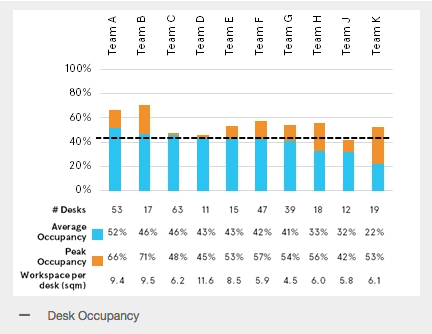Advances in technology and the rise of knowledge work have transformed people’s working patterns. Gone are the days of one-size-fits-all sedentary 9-5 roles – to be replaced by a more varied and dynamic model in which people may increasingly be away from their desk, and away from the office, for a proportion of the working day or week.
 Combined with the ever-increasing costs of office space, this trend opens up the potential to achieve spatial efficiencies by providing only enough desks for the number of people working in an office at any one time, and encouraging agile working across them.
Combined with the ever-increasing costs of office space, this trend opens up the potential to achieve spatial efficiencies by providing only enough desks for the number of people working in an office at any one time, and encouraging agile working across them.
You may also be interested to read: “Are hot desks and shared-desk schemes worth it?”
Take Spacelab’s client, a B2B information and events business looking to reduce their net internal area (NIA) by 35%. This is a risky move that, without data to support it, could be detrimental to the company’s cohesion, identity and working cultures. However, the study identified that, the company’s average desk occupancy was in fact just 43% with no team ever exceeding 71% desk utilisation (see diagram below). What is more, over 100 desks were found to be completely unused. The evidence clearly pointed towards a flexible, non-allocated strategy. It was time to ditch the desk, well quite a lot of them anyway.
 By moving to a 10 to 7 head to desk ratio and providing a range of alternative work settings which meant people no longer stayed in one place to work, the client was able to break down barriers and facilitate greater collaboration among and between teams, whilst operating a more efficient office space. This represented a major cultural shift for the organisation.
By moving to a 10 to 7 head to desk ratio and providing a range of alternative work settings which meant people no longer stayed in one place to work, the client was able to break down barriers and facilitate greater collaboration among and between teams, whilst operating a more efficient office space. This represented a major cultural shift for the organisation.
Whilst the option to lose desks and save space and therefore money sounds ideal, it all depends on what people really need to work productively. Understanding if it’s right for everyone in your business is where the science of how people use space becomes essential.
Therefore, the rigour of our approach was pivotal in understanding the business and its issues and recommending what spatial strategy was appropriate for the company. Furthermore, an additional change management programme assured the client, and employees, that the strategy was achievable.
As a result, the successful implementation of flexible working has reduced churn costs for the client and created an attractive work environment for staff, which is in turn an important factor in recruiting and keeping talent.
First posted 25 June, 2015 on Spacelab https://wearespacelab.wordpress.com/2015/06/25/three-unexpected-ways-to-boost-your-office-potential-2-time-to-ditch-the-desk/
Spacelab are recognised partners of Condeco.